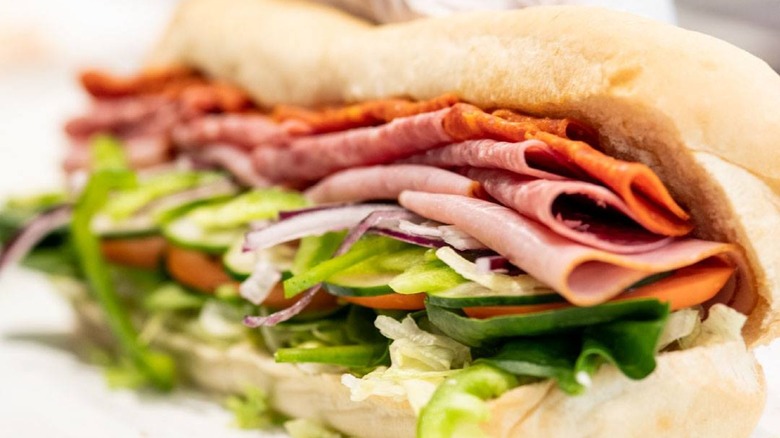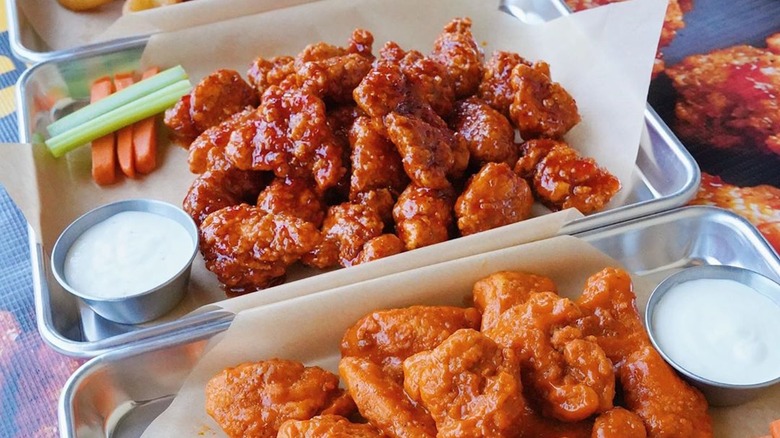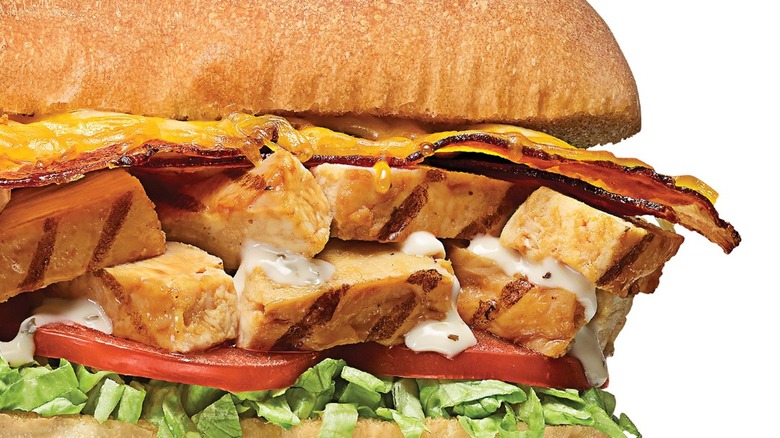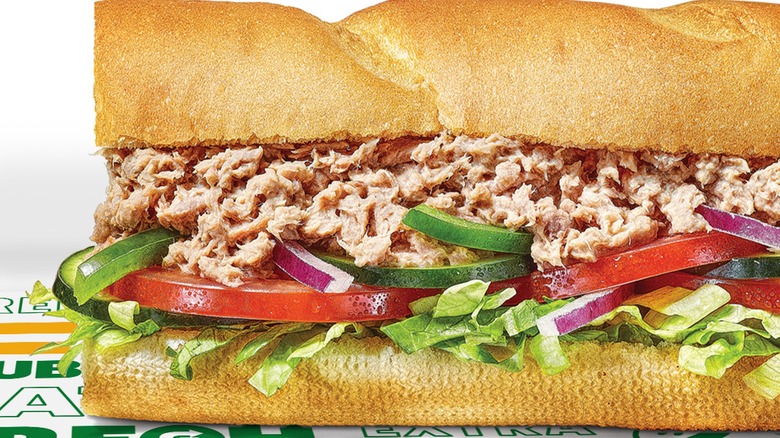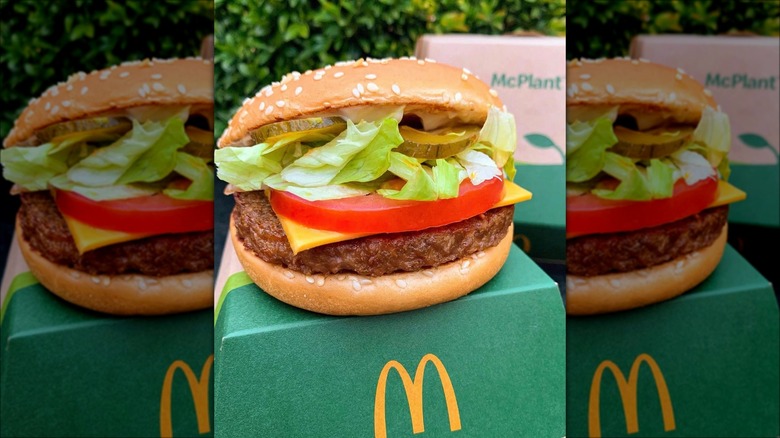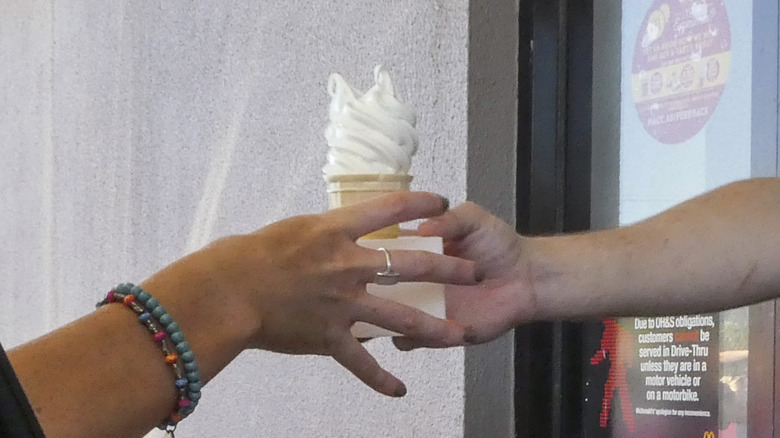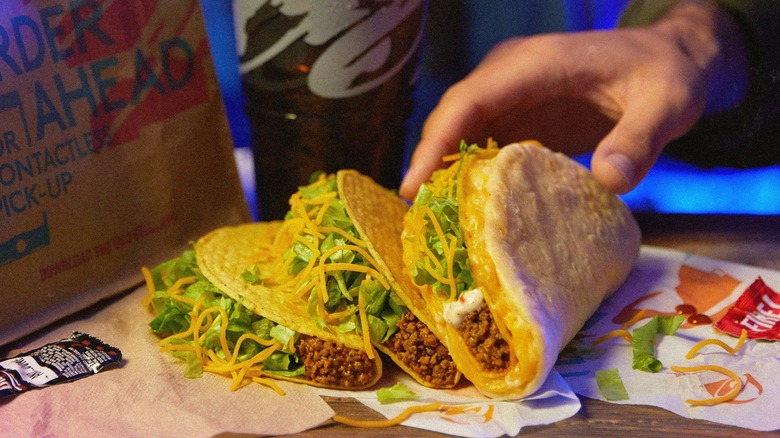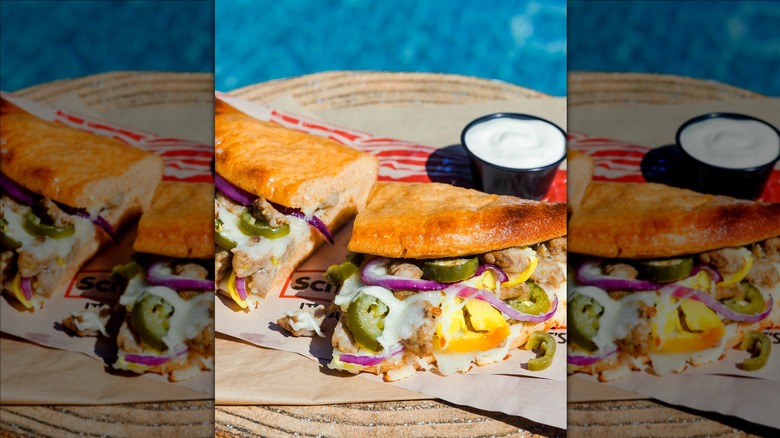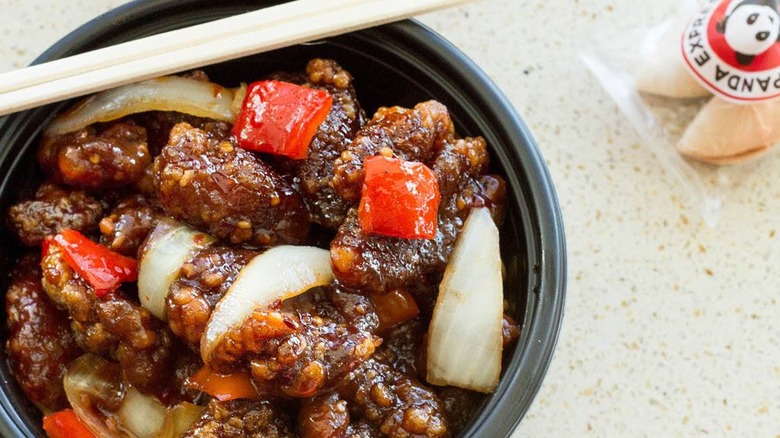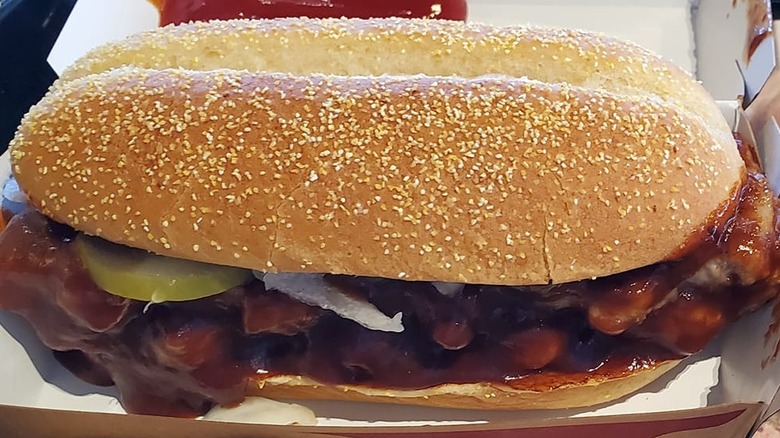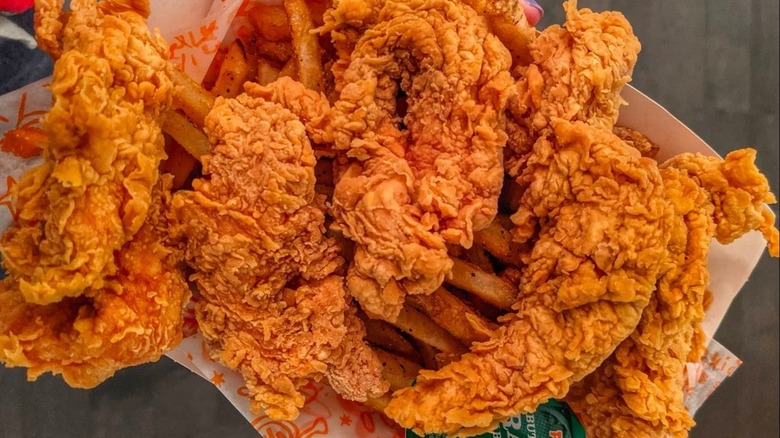Fast Food Menu Item Names That Are Actually Misleading
If you've ever felt betrayed by the name of a misleading fast food item that wasn't what you thought you were getting, you're not alone. Sometimes menu and ingredient names can give us a false sense of what to expect.
You have to ask yourself where the line is between false representation and something everyone should know. For example, you don't expect a hotdog to be made with dog meat, but you do expect Nashville hot chicken to contain chicken. It's helpful when there's a legal definition, like with ice cream and chicken tenders. Some of the problems come with adopting food names from other cultures to try to describe an American invention. Other times, the problems come from what seems like blatant misrepresentation. In some cases, customers have been so upset about getting something different from the name of the item promised that they've sued the companies.
We've found quite a number of misleading menu item names at fast food restaurants. While some may seem obvious, others may surprise you. At the very least, we hope you come away from this article feeling more informed about what's in some of your favorite fast food menu items that you didn't expect.
Subway's bread is technically cake in Ireland
When you think of Subway, you likely think of the smell of fresh-baked bread wafting from the store. However, Subway bread has so much sugar that it's actually considered cake in Ireland. So, next time you enjoy a sub from Subway, keep in mind that you're eating it on a loaf of Italian herbs and cheesecake, artisan Italian cake, or hearty multigrain cake rather than bread. Dessert for lunch, anyone?
The bread at Subway in Ireland officially lost its designation as bread in 2020 to match it to the correct tax. Bread dough can't be more than 2% sugar to qualify as bread and get a lower tax rate, but Subway's bread is 10% sugar. Now you know why it smells so good inside a subway; they're basically baking cake and cookies.
Speaking of cookies, when you eat a 6-inch sub sandwich on Hearty Multigrain Bread, the bread portion has 4 grams of sugar, which is slightly less than eating as much sugar as two cookies in Ireland. Meanwhile, a Subway chocolate chip cookie has 18 grams of sugar. We hope you have a sweet tooth if you're eating at Subway.
Buffalo Wild Wings boneless chicken wings aren't wings
In 2023, a Chicago man named Aimen Halim sued Buffalo Wild Wings for serving boneless chicken wings that weren't really wings. Buffalo Wild Wings wasn't shy when it came to the truth about its wings and made a post on X (formerly known as Twitter) to say, "It's true. Our boneless wings are all white meat chicken. Our hamburgers contain no ham. Our buffalo wings are 0% buffalo." An X (formerly known as Twitter) commenter also pointed out, "Girl Scout Cookies are 0% Girl Scouts." You can certainly take the whole name thing too far. Halim swore that he felt cheated by getting a glorified chicken nugget rather than a deboned chicken wing. He may not have purchased them if he had known what he was getting for the price.
As you can probably guess from Buffalo Wild Wings' social media response to the lawsuit, it had no plans to offer actual deboned wings and will continue serving the same product it has for over 20 years. What is called boneless wings on the menu will continue to be just boneless white meat chicken.
Subway chicken sandwiches in Canada tested as only half chicken
When you order chicken on your Subway sandwich, you assume that you're getting just chicken. Right? When the Canadian Broadcasting Company (CBC) tested grilled chicken from Subway using a Trent University lab in 2017, the DNA results came back as only being about half chicken (or less).
When CBC tested Subway's chicken in Quebec, it also tested chicken from other fast food restaurants. A&W's, McDonald's, Tim Hortons, and Wendy's chicken all came back testing at a range of 84.9% to 89.4% chicken. So, Subway's chicken only coming in at 42.8% to 53.6% chicken was a big shocker. The rest of the DNA came from soy, which could be a serious problem for someone with a soy allergy. When presented with this data, Subway made a statement saying, "Our recipe calls for one percent or less of soy protein in our chicken products. We will look into this again with our supplier to ensure that the chicken is meeting the high standard we set for all of our menu items and ingredients" (via CBC).
The whole debacle has resulted in a couple of lawsuits. Subway sued CBC for defamation, but Subway ended up having to pay CBC $500,000 in legal fees instead. There's also a class action lawsuit pending to represent anyone who ate chicken at Subway between February 2014 and December 2017.
Subway may have sold tuna sandwiches that weren't 100% tuna
Subway was in the news again in 2021 for selling tuna sandwiches that weren't all tuna. Tuna salad traditionally includes ingredients like mayonnaise, but you also expect some tuna. However, none was detected in 19 of the 20 samples that Nilima Amin had a marine biologist test from 20 different Subway locations. Something sounds fishy there for sure.
So, what DNA was in the tuna salad instead of tuna? According to the lawsuit, it came from a variety of animals, including chicken and pork. Such ingredients could be extremely distressing for people suffering from Alpha-gal syndrome (which causes an allergy to mammal meat) or who don't eat pork for religious reasons. To test the lawsuit's claim, the New York Times sent samples of Subway tuna to a lab, too. The lab report came back saying, "No amplifiable tuna DNA was present in the sample." Furthermore, it said, "We cannot identify the species." The lab explained that "it's so heavily processed that whatever we could pull out, we couldn't make an identification. Or we got some and there's just nothing there that's tuna."
Even though the case was dismissed in 2023, there is still an aura of questionability surrounding Subway's tuna from that era with some (but not all) lab tests coming back negative for tuna. However, Subway maintains that it has always sold tuna that was and is "high-quality, premium and 100% real."
McDonald's McPlant burger wasn't technically vegan or vegetarian
Vegetarians and vegans were hopeful in 2022 when McDonald's finally launched its McPlant burger in select locations. Unfortunately, it didn't do well because it didn't taste that great. Plus, it wasn't technically vegan or vegetarian.
In this instance, the ingredients weren't nearly as problematic as the cooking method. The ingredients included peas, rice, and potatoes, which are all vegetarian and vegan. It came with cheese and mayonnaise, but vegans could always ask to omit those toppings. Despite the patty being certified vegan, the problem came from the fact that the McPlant was cooked on the same grill as meat, which cross-contaminated it. While not the norm, a McDonald's customer in England even found a piece of bacon on his McPlant burger. The soggy and unpleasant texture didn't help the McPlant much either. If McDonald's resurrects the McPlant, it needs to have an improved texture and a dedicated grill space away from meat juices. However, with the low sales number in the trial, we don't know whether to expect it to make a resurgence.
McDonald's vanilla soft serve may not be made with real vanilla
In the fall of 2016, McDonald's began removing artificial ingredients from some of its menu items like its vanilla soft serve, which is a key ingredient in many of its frozen desserts. One of the changes it made in its frozen desserts included making chocolate and strawberry shakes with high-fructose-corn-syrup-free syrups and using whipped without artificial flavors. You'd assume that vanilla soft serve contained real vanilla, but it's not on the ingredient list.
A class action lawsuit in 2020 claimed that McDonald's uses a vanilla flavoring in its vanilla soft serve that doesn't all come from real vanilla. The ingredient list for a McDonald's vanilla cone mentions that it contains natural flavor but doesn't mention vanilla extract at all. The lawsuit claims that "The representations are misleading because though the flavor is represented as vanilla, the vanilla taste and flavor is not provided exclusively by vanilla but from non-vanilla sources" (via Top Class Actions).
A lot of companies use synthetic vanilla flavors like vanillin instead of real vanilla because it's so much cheaper to buy in bulk than real vanilla flavoring. So, it's a common form of food fraud. Even years after the formation of the lawsuit, McDonald's hasn't added vanilla to its ingredient list for its vanilla soft serve menu items, which makes customers even more suspicious.
Many fast-food chains serve fake ice cream
Speaking of fake components of ice cream, most fast-food chains don't actually serve ice cream in their cones. If you look closely, the dessert menus often list "cones" rather than "ice cream cones" among the restaurants' frozen treat offerings. The word "ice cream" is conveniently missing from these menus. The reason comes down to the legal definition of ice cream.
The U.S. Food and Drug Administration's (USDA) legal definition of ice cream not only requires it to contain dairy ingredients, but it also says that it must contain "at least 10% milkfat, before the addition of bulky ingredients, and must weigh a minimum of 4.5 pounds to the gallon." So, if a restaurant is serving a dairy treat that's less than 10% milkfat and weighs less than 4.5 pounds per gallon, it can't call itself ice cream.
While there are several chains (like Braum's and Sonic) that serve real ice cream, there are plenty more (like McDonald's and Dairy Queen) that serve "fake" ice cream. Does having fake ice cream mean that you're going to enjoy it less than real ice cream? Not necessarily. However, it might change your decision about where to get frozen dessert treats next time if the fat content is important to you. If it does matter, pay attention to the sneaky wording of the frozen dairy dessert treat you're ordering to see what you are or aren't getting.
Taco Bell gorditas are very different from real Mexican gorditas
Most of us (hopefully) aren't under the delusion that Taco Bell sells authentic Mexican food. At best, it's Mexican-inspired. So, it's probably not too surprising that some of its menu item names don't always line up well with what inspired it. The one that seems the furthest from the original to us is its Gorditas, which Taco Bell debuted in 1998.
Taco Bell's and Mexico's versions of gorditas have almost nothing in common. Recipes for real gorditas include a large piece of pan-fried or deep-fried corn masa bread that is split open much like an arepa before being stuffed with ingredients. The deep-fried versions make pockets kind of like pitas have for adding ingredients. The Spanish word "gordita" also insinuates that the sandwich is fat. The Gorditas at Taco Bell come wrapped in a puffy white wheat flatbread tortilla rather than a puffy cornbread outer layer. While the bread is thicker and softer than the average tortilla at Taco Bell, it's nowhere near as fat as a real gordita. There's sometimes even a Gordita Crunch version at Taco Bell that includes a crunchy taco shell, but that's the only time corn comes into play.
Schlotzsky's calzones aren't real calzones
We're not sure what to call Schlotzsky's calzones, but they're not real calzones. They look more like someone took a pizza and folded it in half to make a bready Italian-style taco — although, not all the stuffings are even Italian. So, whatever it is, it's not a real calzone.
Calzones have a long history that begins in Naples, Italy, in the 1700s. One theory is that calzones are named after pants legs since they look like stuffed pants legs, but another theory is that you could eat them while walking. Whichever it is, the whole point of a calzone is that it's a hand pie that's supposed to have all the ingredients completely enclosed inside the breading, turning it into a portable meal.
The calzone's half-moon shape has people theorizing that it started out as pizza that bakers folded in half before baking to enclose the ingredients. However, the edges were folded and sealed before cooking rather than folded after baking like Schlotzsky's has done. When chain pizza restaurants have created something similar to what Schlotzsky's is calling calzones, they've generally had the decency to call it something else. Pizza Hut has something similar called Pizza Hut Melts, and Domino's created a Pizza Fold.
Panda Express' Beijing Beef didn't come from Beijing
When you order from Panda Express, you know you're getting an Americanized version of Chinese food. However, when you see the name of a specific Chinese city associated with a dish, you likely expect it to come from there. Unfortunately, when you start to dig into the history of the Beijing Beef at Panda Express, you'll land nowhere near Beijing.
If you go searching for the origins of this dish, the path will lead you straight through the doors of Panda Inn rather than to Beijing. Panda Inn is a chain of sit-down Chinese restaurants in California that spawned Panda Express. Panda Express' Executive Chief told QSR that Beijing Beef "was inspired by one of the most popular dishes at Panda Inn. Our goal was to create a unique dish that is a combination of crispy, tangy and tasty with both sweet and sour notes to tantalize our guests' palates." As such, a lot of people liken it to a beef version of orange chicken.
A formally-trained Chinese cook who used to work for Panda Express explained the dish on Reddit by saying that it's "Chinese American with Chinese roots. Using a sweet and sour sauce base while also adding chili and garlic. The sweet and sour sauce that's made in America is worlds apart from authentic sweet and sour sauce, but the idea is the same." So, while it has Chinese elements, it's definitely not a recipe imported from Beijing.
McDonald's McRibs aren't made with rib meat
McDonald's McRibs has been making surprise menu appearances since 1981. One bite, and you know there aren't any real rib bones hiding in the molded meat patties that look like a rack of BBQ ribs. While it's easy to still be under the delusion that there's still rib meat in the McRib from the name, the truth is that the meat comes from a different body part altogether.
McDonald's uses ground boneless pork shoulder to make its McRibs. We guess that McRib sounded better than McShoulder. Ribs are also an easier identifiable shape than hog shoulders for a sandwich, so there's that, too. The McRibs also has other ingredients mixed in with the pork shoulder before forming them into patties. Salt brings out its savory flavor while dextrose makes it a bit sweet. There are also several preservatives, including citric acid and two food antioxidants: BHA, and propyl gallate. But, alas, there's no rib meat in the recipe. The description that McDonald's gives for this sandwich is that it's "seasoned boneless pork." You just assumed it was seasoned boneless ribs based on the sandwich's name and shape all these years.
Popeyes chicken tenders aren't made from tenderloins
Just like when you order a chicken leg, when you order chicken tenders, you have a general idea of what you're going to get. For some people, the expectation is that you're getting a tenderloin strip, which is a tender and moist piece of white meat from underneath a chicken's breast. As such, you might have a certain flavor and textural expectations. However, the claim is that Popeyes doesn't use tenderloins to make its chicken tenders at all.
So, what's in Popeyes' chicken tenders if not tenderloins? They're simply made from regular chicken breast meat. For people who are willing to pay the price for chicken tenders expecting tenderloin meat, discovering that it's just regular breast meat can be disappointing. There was even a class action lawsuit started in 2022 for those who felt cheated from paying what they thought was a tenderloin price but only getting regular white meat chicken strips.
Not everyone falls into the camp of assuming that chicken tenders must be made from chicken tenderloins. In fact, the USDA's Poultry Grading Manual defines tenders as "any strip of breast meat." It has a separate definition for tenderloins. So, it's really all about your assumptions. Unless a restaurant labels its chicken tenders as tenderloins, you probably shouldn't expect anything but breast meat.

